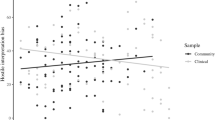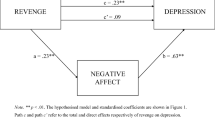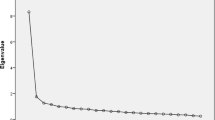Abstract
Cognitive models of social anxiety and depression posit that hostile interpretation bias may be a symptom of, and act as a maintenance factor for, these disorders. Social anxiety and depression are also associated with increased experience of angry and irritable mood. To investigate whether hostile interpretation bias is related to symptoms of the disorder or to irritability, the current study investigated the degree to which state irritable mood may influence these relationships. In two samples, MTurk workers (Sample 1, n = 145) and college students (Sample 2, n = 387), we assessed depression symptoms, social anxiety symptoms, irritable mood, and hostile interpretation bias. In sample 1, depression and social anxiety symptoms were positively associated with hostile interpretation bias. When statistically controlling for irritable mood, depression symptoms no longer significantly predicted hostile interpretation bias. However, social anxiety remained a significant predictor of hostile interpretation bias even when controlling for irritable mood. The pattern of results was identical in sample 2. Results indicate that the association between depression symptoms and hostile interpretation bias may be accounted for by irritable mood, but social anxiety symptoms have a unique association with hostile interpretation bias even when including irritable mood. Clinical implications and future directions are discussed.
Similar content being viewed by others
Notes
Conducting the analyses with IRQ How Much rather than How Often and with the SPS-6 rather than the SIAS-6 did not change the pattern of results for Sample 1 or 2.
References
Amir, N., Prouvost, C., & Kuckertz, J. M. (2012). Lack of a benign interpretation bias in social anxiety disorder. Cognitive Behaviour Therapy, 41(2), 119–129.
Beard, C., & Amir, N. (2009). Interpretation in social anxiety: when meaning precedes ambiguity. Cognitive Therapy and Research, 33(4), 406–415.
Beard, C., Weisberg, R. B., & Amir, N. (2011). Combined cognitive bias modification treatment for social anxiety disorder: a pilot trial. Depression and Anxiety, 28(11), 981–988.
Beck, A. T. (1976). Cognitive therapy and the emotional disorders. Oxford: International Universities Press. Retrieved from http://search.ebscohost.com/login.aspx?direct=true&db=psyh&AN=1976-28303-000&site=ehost-live
Clark, D. M., & Wells, A. (1995). A cognitive model of social phobia. In R. G. Heimberg, M. R. Liebowitz, D. A. Hope, & F. R. Schneier (Eds.), Social phobia: Diagnosis, assessment, and treatment (pp. 69–93). New York: Guilford Press.
Constans, J., Penn, D. L., Ihnen, G., & Hope, D. A. (1999). Interpretation biases in social anxiety. Behavior Research and Therapy, 37, 643–651.
Cornacchio, D., Crum, K. I., Coxe, S., Pincus, D. B., & Comer, J. S. (2016). Irritability and severity of anxious symptomatology among youth with anxiety disorders. Journal of the American Academy of Child & Adolescent Psychiatry, 55(1), 54–61. https://doi.org/10.1016/j.jaac.2015.10.007.
Craig, K. J., Hietanen, H., Markova, I. S., & Berrios, G. E. (2008). The irritability questionnaire: a new scale for the measurement of irritability. Psychiatry Research, 159(3), 367–375. https://doi.org/10.1016/j.psychres.2007.03.002.
Deater-Deckard, K., & Wang, Z. (2012). Anger and irritability. In M. Zentner & R. L. Shiner (Eds.), Handbook of temperament (pp. 124–144). Guilford Press.
Dillon, K. H., Allan, N. P., Cougle, J. R., & Fincham, F. D. (2016). Measuring hostile interpretation bias: the WSAP-Hostility scale. Assessment, 23(6), 707–719. https://doi.org/10.1177/1073191115599052.
Ellard, K. K., Fairholme, C. P., Boisseau, C. L., Farchione, T. J., & Barlow, D. H. (2010). Unified protocol for the transdiagnostic treatment of emotional disorders: protocol development and initial outcome data. Cognitive and Behavioral Practice, 17(1), 88–101.
Everaert, J., Bronstein, M. V., Cannon, T. D., & Joormann, J. (2017a). Looking through tinted glasses: depression and social anxiety are related to both interpretation biases and inflexible negative interpretations. Clinical Psychological Science, 6(4), 517–528. https://doi.org/10.1177/2167702617747968.
Everaert, J., Podina, I. R., & Koster, E. H. (2017b). A comprehensive meta-analysis of interpretation biases in depression. Clinical Psychology Review, 58, 33–48.
Hair Jr., J. F., Black, W. C., Babin, B. J., & Anderson, R. E. (2010). Multivariate data analysis: A global perspective (7th ed.). New Jersey: Pearson Education Inc..
Hirsch, C. R., Clark, D. M., & Mathews, A. (2006). Imagery and interpretations in social phobia: support for the combined cognitive biases hypothesis. Behavior Therapy, 37, 223–236.
Huppert, J. D., Foa, E. B., Furr, J. M., Filip, J. C., & Mathews, A. (2003). Interpretation bias in social anxiety: a dimensional perspective. Cognitive Therapy and Research, 27(5), 569–577.
Huppert, J. D., Pasupuleti, R. V., Foa, E. B., & Mathews, A. (2007). Interpretation biases in social anxiety: response generation, response selection, and self-appraisals. Behaviour Research and Therapy, 45(7), 1505–1515.
Hurst, C. S., Baranik, L. E., & Daniel, F. (2013). College student stressors: a review of the qualitative research. Stress and Health, 29(4), 275–285.
Kashdan, T. B., & Collins, R. L. (2010). Social anxiety and the experience of positive emotion and anger in everyday life: an ecological momentary assessment approach. Anxiety, Stress, & Coping, 23(3), 259–272.
Kroenke, K., Spitzer, R. L., & Williams, J. B. W. (2001). The PHQ-9: Validity of a brief depression severity measure. Journal of General Internal Medicine, 16(9), 606–613. https://doi.org/10.1046/j.1525-1497.2001.016009606.x.
Laurenti, H. J., Bruch, M. A., & Haase, R. F. (2008). Social anxiety and socially prescribed perfectionism: unique and interactive relationships with maladaptive appraisal of interpersonal situations. Personality and Individual Differences, 45, 55–61.
Le Blanc, A. L., Bruce, L. C., Heimberg, R. G., Hope, D. A., Blanco, C., Schneier, F. R., & Liebowitz. (2014). Evaluation of the psychometric properties of two short forms of the social interaction anxiety scale and the social phobia scale. Assessment, 21(3), 312–322. https://doi.org/10.1177/1073191114521279.
Pergamin-Hight, L., Bitton, S., Pine, D. S., Fox, N. A., & Bar-Haim, Y. (2016). Attention and interpretation biases and attention control in youth with social anxiety disorder. Journal of Experimental Psychopathology, 7(3), 484–498.
Perlis, R. H., Fraguas, R., Fava, M., Trivedi, M. H., Luther, J. F., Wisniewski, S. R., & Rush, A. J. (2005). Prevalence and clinical correlates of irritability in major depressive disorder: a preliminary report from the sequenced treatment alternatives to relieve depression study. The Journal of Clinical Psychiatry, 66(2), 159–166.
Peters, L., Sunderland, M., Andrews, G., Rapee, R. M., & Mattick, R. P. (2012). Development of a short form social interaction anxiety (SIAS) and Social Phobia Scale (SPS) using nonparametric item response theory: the SIAS-6 and the SPS-6. Psychological Assessment, 24(1), 66–76. https://doi.org/10.1037/a0024544.
Rapee, R. M., & Heimberg, R. G. (1997). A cognitive-behavioral model of anxiety in social phobia. Behaviour Research and Therapy, 35, 741–756.
Savage, J., Verhulst, B., Copeland, W., Althoff, R. R., Lichtenstein, P., & Roberson-Nay, R. (2015). A genetically informed study of the longitudinal relation between irritability and anxious/depressed symptoms. Journal of the American Academy of Child and Adolescent Psychiatry, 54(5), 377–384.
Smith, H. L., Summers, B. J., Dillon, K. H., Macatee, R. J., & Cougle, J. R. (2016). Hostile interpretation bias in depression. Journal of Affective Disorders, 203, 9–13. https://doi.org/10.1016/j.jad.2016.50.070.
Smith, H. L., Dillon, K. H., & Cougle, J. R. (2018). Modification of hostile interpretation bias in depression: a randomized controlled trial. Behavior Therapy, 49(2), 198–211.
Stoddard, J., Stringaris, A., Brotman, M. A., Montville, D., Pine, D. S., & Leibenluft, E. (2014). Irritability in child and adolescent anxiety disorders. Depression and Anxiety, 31, 566–573.
Vassilopoulos, S. P., Moberly, N. J., & Lau, J. Y. F. (2015). Cognitive bias modification training in children affects anxiety during anticipatory processing of social evaluation. International Journal of Cognitive Therapy, 8(4), 318–334.
Voncken, M. J., Bögels, S. M., & de Vries, K. (2003). Interpretation and judgmental biases in social anxiety. Behaviour Research and Therapy, 41, 1491–1488.
Yarrish, C., Groshon, L., Mitchell, J., Appelbaum, A., Klock, S., Winterntiz, T., & Friedman-Wheeler, D. (2019). Finding the signal in the noise: minimizing responses from bots and inattentive humans in online research. The Behavior Therapist., 42(7), 235–242.
Yoon, K. L., & Zinbarg, R. E. (2008). Interpreting neutral faces as threatening is a default mode for socially anxious individuals. Journal of Abnormal Psychology, 117(3), 680–685.
Author information
Authors and Affiliations
Corresponding author
Ethics declarations
Conflict of Interest
Cassandra K. Marks, Jacob D. Kraft, DeMond M. Grant, and Tony T. Wells declare that they have no conflict of interest.
Experiment Participants
All procedures performed in studies involving human participants were in accordance with the ethical standards of the institutional and/or national research committee and with the 1964 Helsinki declaration and its later amendments or comparable ethical standards.
Additional information
Publisher’s Note
Springer Nature remains neutral with regard to jurisdictional claims in published maps and institutional affiliations.
Rights and permissions
About this article
Cite this article
Marks, C.K., Kraft, J.D., Grant, D.M. et al. The Relationship Between Hostile Interpretation Bias and Symptoms of Depression and Social Anxiety: a Replication Across Two Samples. J Psychopathol Behav Assess 43, 251–258 (2021). https://doi.org/10.1007/s10862-020-09839-y
Accepted:
Published:
Issue Date:
DOI: https://doi.org/10.1007/s10862-020-09839-y




